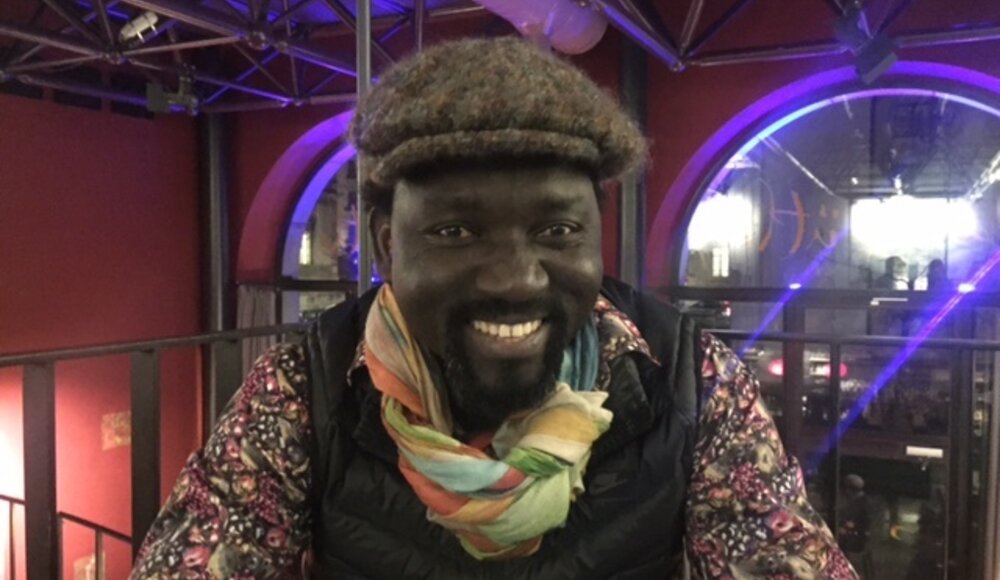 Omar Ba
Omar Ba
"He's reimagining painting!" Malick Ndiaye, artistic director of the Biennale of Contemporary African Art in Dakar, refers to Omar Ba, the author of a work that is both poetic and mysterious. While some of his works are on display at the Biennale, the painter begins a canvas on the floor in the serenity of his Senegalese studio, which is filled with birdsong. A bias at the root of his committed work, calls into question the state of the world and Africa's place in it. "It's like the night: the perspective can get lost... but for me, every object and everything finds its place," he said in the privacy of his studio, at the end of a sandy track strewn with shells from nearby Lake Rose.
His long and imposing figure with bare feet comes to a halt after turning for several minutes around a canvas of more than five meters. He knelt and begins to draw a group of young people. He and this black are in "perfect union." He describes himself as "the color black," "noble and beautiful." "I feel like any other color I put on it will give me exactly what I want," he says. His canvas will soon be populated with hybrid creatures, dreamlike visions with shimmering colors and dizzying detail, where he interacts with the plant, animal, and human kingdoms, after hundreds of brushstrokes. Omar Ba, 45, is a rising star of contemporary African art and one of the collectors' most sought-after artists.
He is one of the 14th Dakar Biennale's sensations, which began on Thursday, May 19. The painter is excited to be exhibiting for the first time in his home country, where he was born into a family of seven brothers and sisters. After abandoning his mechanic training, he began his art studies in Dakar, which he continued in Geneva beginning in 2003. Before the curator Federica Martini discovered his talent in 2009, the artist had been exhibiting in barber shops and cafes. Since his first exhibition in Switzerland in 2010, the artist, who divides his time between Senegal, Brussels, and Geneva, has had his work shown at the Centre Pompidou in Paris as well as many of the world's leading galleries and museums. He has built a studio in the middle of a mango plantation, an hour's drive from Dakar, where he can recharge his batteries. Cows, ducks, exuberant flowers, and birds fly over his paintings and occupy the land.
In the studio, a jumble of materials accumulates, such as the "Typex" correction pens he used to iron his drawings and objects he found for documentation, such as these Second World War magazines. When this grandson of a Senegalese rifleman wanted to condemn the ravages of war, they assisted him in understanding the propaganda. His work is enigmatic, even hallucinatory, and intensely poetic, with creatures with the heads of a goat, a ram, or Horus, the Egyptian deity with the head of a falcon. "This half-man, half-animal characters are a wink to the nature of the human being who, I believe, behaves like an animal in the jungle," he tells. His characters embody the traumas of colonialism, tyranny, violence, North-South disparities, and hope.
In a 2021 exhibition in Brussels, he portrayed several fictitious heads of state seated in front of a table, their hands resting on a book symbolizing the constitution that many real leaders have manipulated in order to remain in power indefinitely. "We can see that Africa wants to go somewhere else, to move... There are wars, overthrown heads of state, and dictatorships; this piques my interest "he claims
"Ba, Omar? But he reinvents painting!" exclaims Malick Ndiaye, artistic director of the Biennale, "it's a powerful and innovative work." "as well as an ongoing research process. Templon, a well-known French gallery, represents Omar Ba. He is currently showing 20 paintings at the Royal Museums of Fine Arts in Belgium, with another show in September in New York and a retrospective in November at the Baltimore Museum. "His work is much more complex than most things you see: his treatment of subject matter, his use of bestiary, and his use of color are strikingly strong and beautiful," says Mathieu Templon, owner of his gallery. "He is one of the most aesthetic and political African artists today."
"An African artist should not be oblivious to what is going on in this continent," says Omar Ba. "We must try to see what we can bring to finally build, pacify, and give hope," he says softly.


 Selena Mattei
Selena Mattei